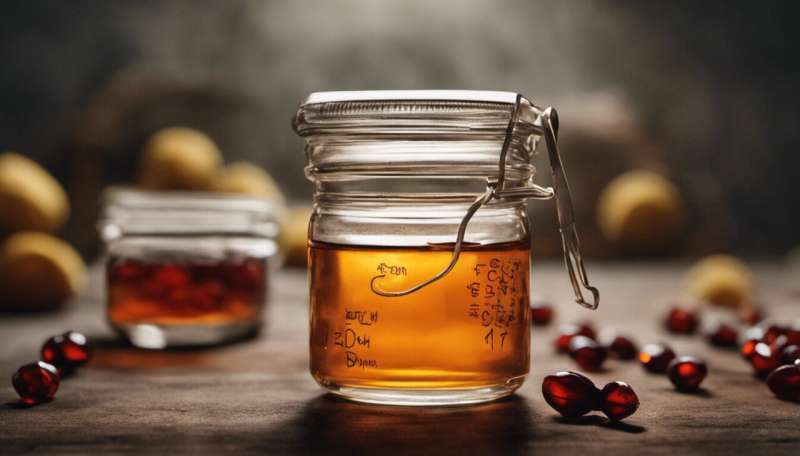This article has been reviewed according to Science X's editorial process and policies. Editors have highlighted the following attributes while ensuring the content's credibility:
fact-checked
trusted source
written by researcher(s)
proofread
Cough syrup can harm children—experts warn of contamination risks

The recent deaths of over 300 children in Africa and Asia have prompted the World Health Organization (WHO) to warn about the use of "substandard and falsified" medical products. The organization called for more efforts to protect children from contaminated medicine. Toxicologists Winston Morgan and Shazma Bashir unpack the story.
What caused the WHO to issue these warnings?
Over the last five months the WHO has issued three alerts warning people not to use specific over-the-counter medicine for children. The warnings came after the deaths of at least 300 children in various countries including The Gambia, Indonesia and Uzbekistan.
Medical product alerts were released in October 2022 for Africa, November 2022 for south-east Asia and for the European region in January 2023.
The WHO issues these warnings only when independent laboratory analysis has confirmed that the product is substandard or falsified and that it poses a significant threat to public health. The threat must also extend beyond one country.
The children died after consuming cough syrup contaminated with ethylene glycol and diethylene glycol, leading to the WHO medical product alerts. Some of the children were as young as five. Cases were reported in at least seven countries.
What are ethylene glycol and diethylene glycol?
Ethylene glycol and diethylene glycol are toxic alcohols with a slightly sweet taste. They are widely used in windscreen wiper fluids and engine coolants.
These compounds are sometimes also found at very low levels as contaminants in many food ingredients and medical solvents (including propylene glycol, polyethylene glycol, sorbitol and glycerin/glycerol). This happens when there are poor standards of manufacturing and testing.
Medical solvents are widely used to dissolve the ingredients of a medicine. Ethylene glycol and diethylene glycol contamination poisonings over the years have mainly been associated with solutions containing paracetamol.
Paracetamol in cough syrups is good and safe for children with infections. It is a pain killer which is good at reducing fever, without causing gastric irritation like aspirin or ibruprofen may do.
Are they dangerous?
Both ethylene glycol and diethylene glycol are seen as toxic. A fatal oral dose is about 1,000-1,500 milligrams per kilogram. For a small child weighing 20kg a fatal single dose would be about 28 milliliters or about 6 teaspoons of pure ethylene glycol. However it is also possible to cause toxicity by consuming much lower doses over several days and weeks. That is why the WHO safe level for these chemicals is only 0.5 milligrams per kilogram per day. That's the equivalent of 1/15th of a teaspoon per day.
What makes these glycols potentially so dangerous is that toxicity comes from the consumption of relatively large amounts before symptoms of contamination appear.
The additional danger from cough syrups is that symptoms of ethylene glycol and diethylene glycol contamination, such as drowsiness, are sometimes observed in children who have not taken contaminated medicine, and can be misinterpreted as normal in a child with a cough or fever. Guardians and medical professionals may not notice what's wrong until it's too late.
What's the role of paracetamol?
To understand the potential role of paracetamol in these poisonings, we need to understand what happens to ethylene glycol and diethylene glycol in the body.
To be toxic, these glycols must be converted to a compound called glycoaldehyde, and then to glyoxylic acid. Glyoxylic acid can concentrate in and damage the kidneys—leading to death from renal failure.
The conversion is triggered by a certain concentration of a coenzyme called nicotinamide adenine dinucleotide (NAD+). NAD+ is regulated by mitochondria—small structures in human cells which regulate many chemical reactions in the body.
In a recent study, we demonstrated that at the normal dose required to treat fever, paracetamol inhibits mitochondria. Thus it affects the level of NAD+ and, in turn, the conversion of glycols to toxins. Children taking paracetamol preparations contaminated with the glycols could potentially be in danger.
We believe that the combination of medicines containing paracetamol and glycols, even when the contamination is relatively low but above the WHO acceptable limit of 0.5 mg/kg of body weight per day, could be lethal.
Unlike other medications or food products which do not disrupt mitochondrial function, preparations containing standard levels of paracetamol are more likely to lead to adverse outcomes for children, because of the increased metabolism of ethylene glycol and diethylene glycol.
Other medicines and foods contaminated with low levels of ethylene glycol and diethylene glycol probably go unnoticed because they don't contain paracetamol.
What must be done to prevent future deaths?
If spotted early enough, ethylene glycol and diethylene glycol poisoning can be treated. The two most widely used antidotes for overdose are fomepizole and ethanol. Both reduce the amount of toxic ethylene glycol and diethylene glycol metabolite produced in the body.
Incidents of mass poisonings highlight the need for greater vigilance in monitoring preparations containing paracetamol.
Medications containing paracetamol are normally very safe for children. But to avoid deaths related to cough syrup in future, both parents and medical professionals should consider glycol poisoning as a possibility if children start to display symptoms of intoxication and drowsiness after taking the medicine.
These incidents generally happen in countries categorized as the global south. Manufacturers and regulatory authorities in these countries also have a responsibility to protect children.
This article is republished from The Conversation under a Creative Commons license. Read the original article.![]()




















